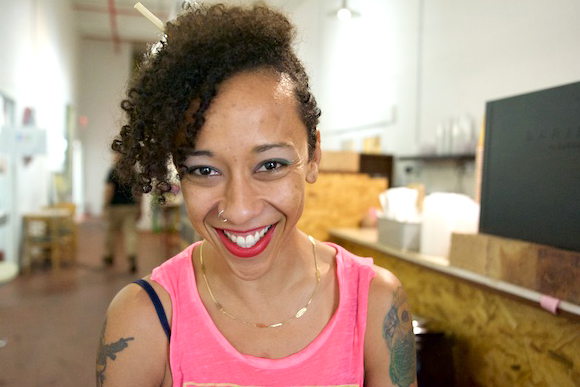
Hattie Mae Williams brings guerrilla dance performances to public places with Tattooed Ballerinas
By Nicole Rupersburg, Creative Exchange Photo of Hattie Mae Williams by Gregory F. Reed.
This article is cross-posted with permission from Creative Exchange. Hattie Mae Williams grew up in Miami and attended the New World School of Arts magnet high school where, she says, she learned a lot about how to use art as a way to promote social change. She then went on to Alvin Ailey American Dance Theatre in New York for her MFA where she became interested in site-specific dance.
“I was starting to see that theatre was predominantly for a certain demographic,” Williams says. “I was learning that a lot of people didn’t go to theatres.” This realization, among others, became the impetus for the Tattooed Ballerinas. “It doesn’t makes sense all the time for me to perform in theatres. The Tattooed Ballerinas formed because I was finding it difficult to fit into this certain structure. People had a certain idea of what a dancer was, a certain aesthetic. But the people I was working with, including myself, [we didn’t really] fit into this aesthetic.”
She wanted to create a place where people like her – both dancers and audience members alike – felt comfortable, where there wasn’t this sort of stilted perception of the theatre that is only for certain people (as audience members) and only embraces certain people (as performers).
And yes, Williams has tattoos.
The Tattooed Ballerinas, which Williams describes as “more of a movement than a company,” does site-specific performances in nontraditional locations intended to reach a wider audience. The guerilla performance group explores spaces that people already occupy and promotes the idea that these are spaces that can be used differently. Since 2003, Williams and her fellow performers have put on performances in public places like laundromats, grocery stores, empty lots, Target stores, abandoned churches, and bus stops.
“We’re reaching an audience that has always been interested in the arts but didn’t really feel the theatre was their place,” she explains. “[The theatre community] shot [itself] in the foot by making it exclusive. There’s no real connection between the performer and the audience in the theatre. Some things definitely call for that atmosphere but some things really call for interaction, not just ‘you have your gaze on me and I’m entertaining you.'”
Williams has kept her foot in both worlds – that of the professional “Uptown” world as well as the guerrilla-style performance world of her own making. It’s important to be able to pull from both worlds, she says, and while there were some eyebrows raised when she first started the Tattooed Ballerinas project, she is finding that nontraditional site-specific performances and cross-genre collaboration are becoming more the norm.
“Site-specific dance has a long lineage of history where people were making these happenings and doing this performance art,” she says. “[When I first started] people were curious [but also thought], ‘That’s just Hattie being Hattie,’ with me walking around in my skin color with tattoos doing modern and classic ballet. Now it’s becoming more of a practice, like, ‘Of course, why wouldn’t you do this performance in Walgreens?'”
The Tattooed Ballerinas is interdisciplinary and project-based, with artists – dancers as well as visual artists – in New York and Miami, where Williams moved back about a year ago.
“My whole goal is to reclaim community spaces,” she says. “It’s kind of bizarre that there’s not any real community spaces outside of commercial [space in Miami].”
This desire took shape as the Miami Sites Project, a two-part site-specific piece that is part performance, part documentary, and all cross-collaborative. The first took place at The Miami Marine Stadium and the second will be at The Venetian Pool in Coral Gables, both public places that are significant pieces of Miami’s history.
She just finished filming at the Miami Marine Stadium, a structure built in the 1960s that has been abandoned for 20 years. Previously used as a gathering space for various events, it has been closed since Hurricane Andrew stormed through. Much as the Tattooed Ballerinas are guerilla performance artists, guerilla graffiti artists have since taken over the space, covering every square inch in graffiti. The Miami Sites Project, which was awarded a Knight Arts Challenge grant, is a site-specific dance performance with a coordinating film documenting the performance and the space.
“Archiving and documenting is a really important part of my work,” Williams says. “The friends of the Miami Marine Stadium are trying to raise funds to reopen that space but there is talk that maybe it won’t reopen. I thought it is important to Miami history to document it.”
She is particularly interested in the history of the site and what it is being used for now. The Miami Marine Stadium is located on an island that was once a Black-only beach, were Black soldiers were trained how to swim during WWII. Sewage from the luxury (and white) Fisher Island nearby was also pumped out there when it was Black-only. “I went into this project thinking this is a beautiful space and an amazing historical structure, then all these other things started coming up.”
Williams feels a creative energy bubbling in Miami, one that exists beyond the glorified spring-break-in-December that is Art Basel, and one she wants to be a part of. “Artists are more motivated to create a scene that people can benefit from,” she says. “I definitely wanted to be a part of that because [I saw] a lot of things were changing here. This is my home. I wanted to be a part of that influence. New York has fed me but it was also sucking me dry. If I’m going to invest and give back, I’m going to do it in my hometown.”
Recent Content
-
Artsarticle ·
-
Artsarticle ·
-
Artsarticle ·
